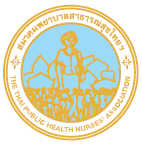การศึกษาปัจจัยทำนายภาวะแทรกซ้อนให้ผู้เป็นเบาหวานในชุมชนภายใต้ทฤษฎีการพยาบาลของคิง1
Keywords:
ผู้เป็นเบาหวาน, ภาวะแทรกซ้อน, ปัจจัยทำนาย, ทฤษฎีการพยาบาลของคิง, Diabetes patients with complication, Complication, Predictive factors, King’s nursing theoryAbstract
การวิจัยเชิงสำรวจครั้งนี้มีวัตถุประสงค์เพื่อศึกษาปัจจัยทำนายภาวะแทรกซ้อนผู้เป็นเบาหวานชนิดที่ 2 ในชุมชนภายใต้ทฤษฎีการพยาบาลของคิง กลุ่มตัวอย่าง คือ ผู้เป็นเบาหวานชนิดที่ 2 ที่มีภาวะแทรกซ้อนและมีอายุ 35 ปีขึ้นไปในอำเภอนครชัยศรี จังหวัดนครปฐม จำนวน 300 คน เครื่องมือที่ใช้เป็นแบบสัมภาษณ์ ที่สร้างตาม แนวคิดระบบบุคคล ระบบระหว่างบุคคลและระบบสังคมของคิง วิเคราะห์ข้อมูลด้วยค่าเฉลี่ย ส่วนเบี่ยงเบน มาตรฐานและการวิเคราะห์ถดถอยแบบขั้นตอน ผลการวิจัยพบว่า กลุ่มตัวอย่างส่วนมากเป็นเพศหญิง อายุระหว่าง 56 – 65 ปี สำเร็จการศึกษาระดับ ประถมศึกษา ไม่ได้ประกอบอาชีพ รายได้ของครอบครัวเฉลี่ยต่อเดือน 5,001 – 10,000 บาท จำนวนสมาชิกใน ครอบครัว 3 – 5 คน ป่วยด้วยโรคเบาหวานมานาน 1 – 5 ปี มีความคิดเห็นเกี่ยวกับการปฏิบัติตนเพื่อป้องกัน ภาวะแทรกซ้อนซึ่งตรงกับแนวคิดในระบบระหว่างบุคคลมากที่สุด รองลงมา คือ ระบบบุคคลและระบบสังคม
ภาวะแทรกซ้อนที่ศึกษามีทั้งหมด 4 ปัจจัย คือ น้ำตาลในเลือดสูง ภาวะแทรกซ้อนทางตา ทางไต ทาง ระบบประสาทและการเกิดแผลที่เท้า ผลปรากฏว่าปัจจัยที่สามารถทำนายการเกิดภาวะน้ำตาลในเลือดสูง คือ ความสามารถในการควบคุมโรคของตนเอง โดยอธิบายการเปลี่ยนแปลงของน้ำตาลในเลือดได้ร้อยละ 3.0 ปัจจัยที่ สามารถทำนายภาวะแทรกซ้อนทางตา คือ ระยะเวลาที่เป็นโรค โดยอธิบายการเกิดภาวะแทรกซ้อนทางตาได้ ร้อยละ 1.5 ปัจจัยที่สามารถทำนายการเกิดภาวะแทรกซ้อนทางไต คือ ฐานะทางเศรษฐกิจและระยะเวลาที่เป็น โรคเบาหวาน โดยฐานะทางเศรษฐกิจ อธิบายการเกิดภาวะแทรกซ้อนทางไตได้ร้อยละ 9.8 และระยะเวลาที่เป็น โรคเบาหวาน อธิบายการเกิดภาวะแทรกซ้อนทางไตได้ร้อยละ 11.9 ปัจจัยที่สามารถทำนายการเกิดภาวะแทรกซ้อน ทางระบบประสาทและการเกิดแผลที่เท้า คือ อายุ การรับรู้ต่อบทบาทของคนในครอบครัวในการจัดการเบาหวาน ให้ผู้เป็นเบาหวานและความเครียด โดยอายุอธิบายการเกิดภาวะแทรกซ้อนทางระบบประสาทและการเกิดแผลที่ เท้าได้ร้อยละ 2.6 บทบาทของคนในครอบครัว อธิบายการเกิดภาวะแทรกซ้อนทางระบบประสาทและการเกิดแผลที่เท้า ได้ร้อยละ 4.2 ส่วนความเครียด อธิบายการเกิดภาวะแทรกซ้อนทางระบบประสาทและแผลที่เท้าได้ร้อยละ 5.5
ข้อเสนอแนะจากการศึกษา พยาบาลเวชปฏิบัติชุมชนควรนำปัจจัยที่มีอิทธิพลต่อการเกิดภาวะแทรกซ้อน จากโรคเบาหวานมาออกแบบระบบการให้บริการสุขภาพให้แก่กลุ่มผู้เป็นเบาหวานที่เสี่ยงต่อการเกิดภาวะ แทรกซ้อนโดยเน้นการมีส่วนร่วมของผู้เป็นเบาหวาน ครอบครัว ผู้นำชุมชน บุคลากรสุขภาพ รวมถึงอาสาสมัคร สาธารณสุข ออกแบบการเยี่ยมบ้านโดยเน้นสร้างการรับรู้ที่ถูกต้องของคนในครอบครัวในการประเมินความรู้ความ เข้าใจและประเมินการมีส่วนร่วมในการดูแลผู้เป็นเบาหวานในครอบครัว
THE STUDY OF PREDICTIVE FACTORS’ COMPLICATIONS OF DIABETES MELLITUS CLIENT IN COMMUNITY UNDER KING’S NURSING THEORY
The survey research objectives was to examine the predictive factors of complication of Diabetes Mellitus patients in community under King’s Nursing Theory. The sample included 300 diabetes types 2 patients with complications, aged of 35 years or higher, in Nakornchaisri, Nakornprathom province. The questionnaire was enquired about personal information, and heath behaviors related to individual, interpersonal, and social system in King’s Nursing Theory. The data were analyzed by Mean, Standard deviation, and stepwise regression analysis.
The results have shown that respondents mainly were female, age ranged between 56-65 years, primary school level, unemployed, income ranged 5,001-10,000 baht monthly, family member ranged 3-5 persons. A length of sickness with diabetes was 1-5 years. The diabetes patients had the highest level of health behaviors for preventing complication in interpersonal level, followed by individual and social level, respectively.
The studied complications of Diabetes Mellitus patients were blood sugar level, eye complication, renal complication, nervous complication, and footsore. The predictive factor for blood sugar level was patient’s care ability in diabetes complications. When patient’s care ability in diabetes complications increased in 1 point, the blood sugar can be reduced 2.337 points. It can explain the changing of blood sugar by 3.0%. The predictive factor for eye complication from diabetes was a length of diseases. When a length of disease was one point or higher, the eye complication was increased 0.009 point. It can explain eye complication by 1.5%. The predictive factors for renal complication were economic status and length of disease. If the economic status of diabetic patients improved 1 point, the rental complication increased by 2.538 point. It can explained the renal complication by 9.8%. When a length of disease increased by 1 point , the rental complication increased by 0.018 point, while the length of disease can explain the onset of renal complication by 11.9 %. The predictive factor for nervous complication and footsore included age and perception of family member’s role in diabetes management and stress. When the age increased for one point, the nervous complication was increased by 0.007 point. It can explain the nervous complication by 2.6%. While the family member’s role in diabetes management increased by 1 point, the nervous complication was decreased by 0.016 point. It can explain the nervous complication by 4.2%. When the diabetes patients’ stress increased by 1 point, the nervous complication increased by 0.116 point., It can explain the nervous complication by 5.5%. The results suggested that the community nurse practitioners should take those significant factors for designing health care service system by empowering family members, community leaders, health personnel, and health community volunteers to help the recipient who risk to have diabetes complications
Downloads
How to Cite
Issue
Section
License
บทความที่ตีพิมพ์และแผนภูมิรูปภาพถือเป็นลิขสิทธิ์ของวารสารพยาบาลสาธารณสุข (Thai Public Health Nurses Association)






